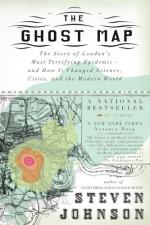|
This section contains 586 words (approx. 2 pages at 400 words per page) |

|
The Ghost Map Summary & Study Guide Description
The Ghost Map Summary & Study Guide includes comprehensive information and analysis to help you understand the book. This study guide contains the following sections:
This detailed literature summary also contains Topics for Discussion on The Ghost Map by Steven Johnson.
The Ghost Map tells the story of the cholera epidemic of 1854 in Victorian London. It also describes the investigative work accomplished by two Londoners who were determined to find the source of the scourge. Victorian London was over-crowded and had not established a waste system that separated clear drinking water from sewage. There was a shadow world of scavengers who trudged through the contaminated Thames River where the sewage from three million people wound up. When the sewage contaminated clear water it was the precursor for the spawning of the cholera bacterium.
Thomas and Sarah Lewis lived in Soho on Broad Street within an area that was known as the Golden Square. Most of the residents of London Square were middle and upper class Londoners who tended to look down on the Soho residents. Soho was located in the central part of the Golden Square and was a cross-mixture of the classes and a place that attracted artists and socialists and even drew the interest of a Prussian immigrant named Karl Marx who lived there with his young family.
In August 1854, the five-month-old daughter of Thomas and Sarah Lewis became ill. The source of her illness was unknown at the time. She had diarrhea that required a constant changing of her diapers. The soiled cloth diapers were soaked in vats of water and then washed. The wash water was disposed of in a local cesspool that fed the Broad Street pump, a source of clear water that many in the neighborhood relied upon for the drinking and cooking water. Her waste accumulated in the cesspool and bred the cholera bacteria that ultimately contaminated the water and caused the cholera outbreak. Cholera bacteria breeds in human excrement and infects the small intestine of those who ingest it. The person sheds massive amounts of water diarrhea and becomes so dehydrated that the heart works overtime to keep circulation up. Eventually the organs shut down and the heart stops.
Dr. John Snow was a physician an anesthesiologist who had done pioneer work on the application of ether and chloroform to dull the pain of surgical procedures. Prior to his work, surgery patients had to grin and bear it. Queen Victoria was one of the first patients to use chloroform. She summoned Snow to administer the anesthesia during the birth of her eighth child. Snow was also interested in cholera epidemics and had done extensive research on an early outbreak in London.
During the Soho Epidemic, also known as the Broad Street Epidemic, Snow was intrigued by the sources and causation of the epidemic. From his prior work and knowledge about epidemics, he became certain that the disease was waterborne. He had to fight off critics who ridiculed him over his thesis. The cause that was popularly held by most scholars and scientists at the time was that cholera was an airborne disease caused by the stench from the contaminated Thames River.
Snow ignored his skeptics and remained resolved to prove his theory. One of his skeptics was a local Soho curate from St. Luke’s who knew the people and geography of Soho. The young curate, Henry Whitehead was dedicated to visiting the sick and dying during the epidemic and bringing as much comfort as he could to them. He began to see signs that told him that cholera was not airborne and ultimately was swayed to ascribe to Snow’s waterborne theory. Together Snow and Whitehead proved the waterborne theory and discovered who patient zero was.
Read more from the Study Guide
|
This section contains 586 words (approx. 2 pages at 400 words per page) |

|



